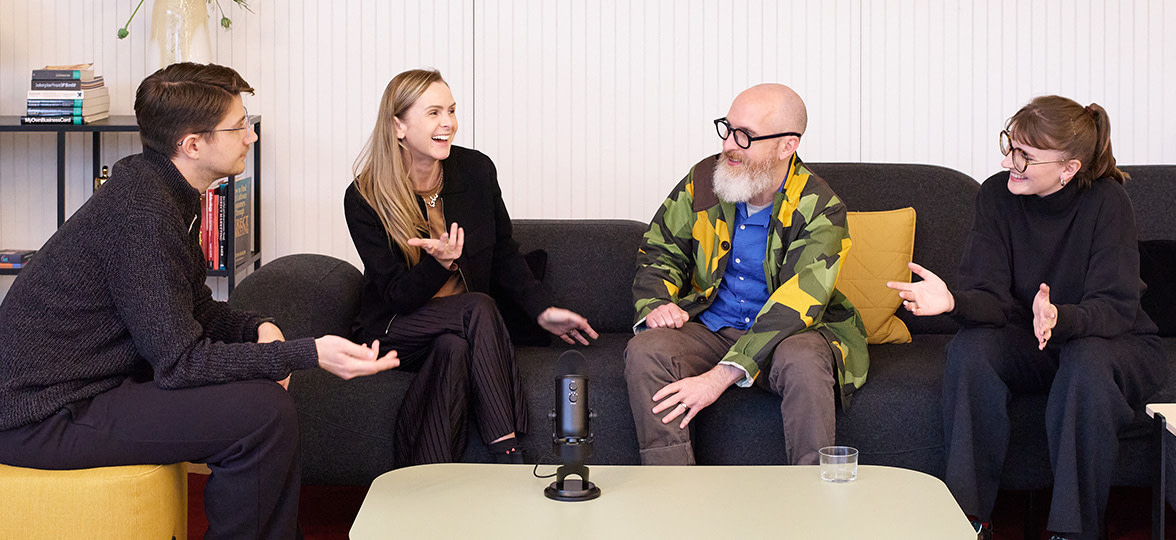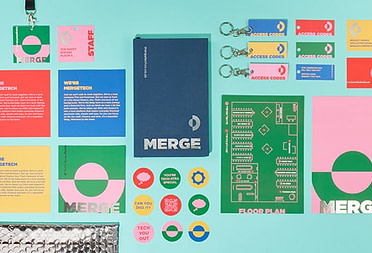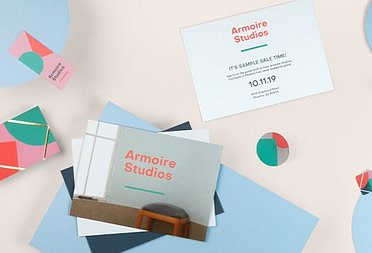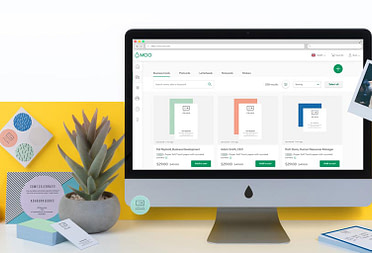AI in design: MOO’s take on the pros and cons
Get the lowdown on AI in design with our creative panel at MOO.

As the technology behind AI progresses, it’s no surprise that it’s going to have an impact on the creative industry. But what does this mean for the future of design as we know it?
To get some insight into this exciting new world, we spoke to four members of our creative team here at MOO, to weigh in on the good and the bad sides of AI. So who’s on the panel?
- James North, MOO’s Creative Director
- Millie Davies, MOO’s Head of Design
- Phil Bailey, MOO’s Head of Art Direction
- Chynna Guyat, MOO’s Junior Photographer
This is a MEATY topic – so let’s dive in.
Does AI threaten organic design?
When it comes to the design and creative process, AI can be viewed as both an opportunity and a potential threat. On one hand, AI technology has the potential to enhance the work of designers, offering new tools and capabilities that can aid in the creative process. However, concerns have been raised about AI’s potential impact on authentic human creativity and ‘unique’ ideas.
Phil: “My personal view is that AI is quite exciting, in terms of aiding the creative process. It is a threat to some areas of the job, but I don’t think it is a threat to jobs in design, because it can’t have a creative eye”.

James: “What we’re using now is on one side, which is idea generation and automation – things that can speed up that process so we can concentrate on where we’re adding the most value. Which isn’t a threat because it’s supportive. And it’s this supporting role, rather than taking it all on, which is where AI feels most beneficial to us right now”.
Millie: “Some companies value creativity more than others. And therefore the threat of AI is going to be greater and lesser depending on those businesses. At MOO we really value creativity and insight, and thinking about the holistic picture. AI isn’t there yet”.
Is the quality of AI design actually any good?
AI is capable of producing graphics, illustrations, photography and even video. What’s more, it can analyze vast amounts of data, identify patterns, and generate designs that humans may not have thought of. But is it this lack of unique, human thought and biased algorithms where AI falls short?

James: “Great design has care, attention, detail and time spent on it. If we moved all of our design over to AI, that’s potentially the same AI that any other competitor can use. You need those human, happy accidents or nuances that particular designs can bring to that world. Is great design a logo that just looks good, or is it the story behind its creation?”.
Millie: “AI can support, but when it comes to that rich history and understanding the brand and designing specifically for them – surely that’s great design? Because it really solves a problem and makes a difference”.
Phil: “A lot of the AI examples that you see from a creative point of view aren’t really ‘great design’. The renders just aren’t that good. They could be in the future, but often if you’re feeding in a text to image prompt there’s something always off about the results. To the untrained eye that’s probably fine – but if you are looking for great design, I don’t think you’re getting that from an AI platform”.
How have you been experimenting with AI tools this year?

From Adobe Firefly to Foto AI, there is a wide variety of AI tools out there to support designers and photographers as they continue to explore this new area. We chatted further to our Junior Photographer, Chynna, and discovered how she’s been experimenting with AI tools to support her photography work.
Chynna: “From a photography and artworking perspective I’ve been using Firefly in Adobe Photoshop. It’s really helpful if, for example, I need to extend part of a table, or part of a floor. It saves me a lot of editing time! In my experience playing around in Photoshop, combining photography and enhancing it with AI has been really fun.
For the below design, it was really just pure experimentation. I shot the foundations of it in the studio. I had a blue backdrop, because I knew I wanted to add a sky. So I gave it something to work with. And I had a mirror on the table, because I knew I wanted to reflect it and for it to look like water too. Using the AI tools in Photoshop helped enhance it, making the sky look real(ish) and adding ripples to the mirror to look like water”.

James: “What’s great about AI experimentation is that we’re all coming in pretty much at the same time and learning what works. So there is kind of a fair playing field, the more we play the more we learn and the more we can use it. Chynna’s attitude is a really positive one of ‘I’m going to use this tool’ rather than ‘I’m going to fear this tool’”.
What’s your opinion on providing ‘full disclosure’ when using AI?
Disclosure is incredibly important when it comes to AI. Transparency plays a key role in ensuring that customers are aware of the processes involved, which in turn helps to foster authenticity and maintain a positive brand image. The Adobe Content Authentication Initiative, for example, has played a significant role in helping keep things honest in AI-powered design. Our team shared their thoughts:
Phil: “There’s general skepticism around all media creative nowadays. And Adobe’s step forward in this space is really important, and actually really clever. And as more and more businesses integrate AI into their customer offering, it’s important to put guidelines and policies in place. Adobe are helping drive the democratization of AI in design programmes, but they’re also able to watch what’s being typed in and learn and feed from the designs too, which is really valuable for their business”.
Millie: “It needs to be authentic. As long as there’s that honesty and you’re showcasing where you’re using it and how, then there shouldn’t be any issues with it. As long as you’re not using it in a way to manipulate customers to buy”.

James: “At MOO, We’ve stayed true to making physical products, and focusing on the beauty of those in-person moments. And our products are built on tech, so it’s about making sure that tech is giving our customers the best experience, rather than just making our lives easier. It’s about truthfulness, and making sure a customer can feel comfortable with what they’re seeing or experiencing. That’s really needed so that there’s a universal understanding of what is real and what is fake”.
Has AI made us lose touch with the real world?
In an era of technological advancement, are we losing touch with the offline world and our authentic selves? With all the answers at our fingertips 24/7, we asked our panel for their thoughts on the value of analog versus digital when it comes to ideation itself.
James: “Analog tools allow for unique thoughts. With Pinterest, there is a homogenization of design, where everything starts to look very similar. And AI is just increasing that again. So deliberately going the other way and doing something which is purely from your own brain, using your own tools, has a massive cut through.”
Millie: “The more you have digital platforms in your day to day the more you’ll potentially get home and feel that you need to draw or write something out, versus typing it. You almost want to counter the culture of ‘digital first’. And I guess that’s where MOO really does have a place in the market, because we do value the physical. The digital stuff can massively aid all of this, but you can’t lose that human interaction, and pen to paper. Digital never gets close to that.”
Do you have any top tips for anyone looking to leverage AI?
At MOO, we’re all for embracing change and staying ahead of innovations in the design world. The key is understanding how AI can assist in the design process without taking over or replacing human creativity. We asked our Creative Director, James, for some parting thoughts on the best way for you (and MOO) to get the most from AI in 2024.

James: “AI can be used as a search tool, to understand where your brand currently sits. Right now, it’s a research tool as opposed to an output tool. And this goes for visual identity too. It can help people think more about their brand. It’s great for ideation, fuelling ideas, and questioning new areas. I don’t think that the real value is in the output, it’s in the input. Otherwise we all risk looking the same eventually”.
AI’s role in design is a complex and evolving dynamic, and is undoubtedly set to have a significant impact on the design industry. And as our creative panel have pointed out, its potential benefits and drawbacks are both significant and must be carefully navigated.
The future of AI in design is undoubtedly exciting – and it’s up to us to ensure that we make the most of it.
Keep in touch
Get design inspiration, business tips and special offers straight to your inbox with our MOOsletter, out every two weeks.







